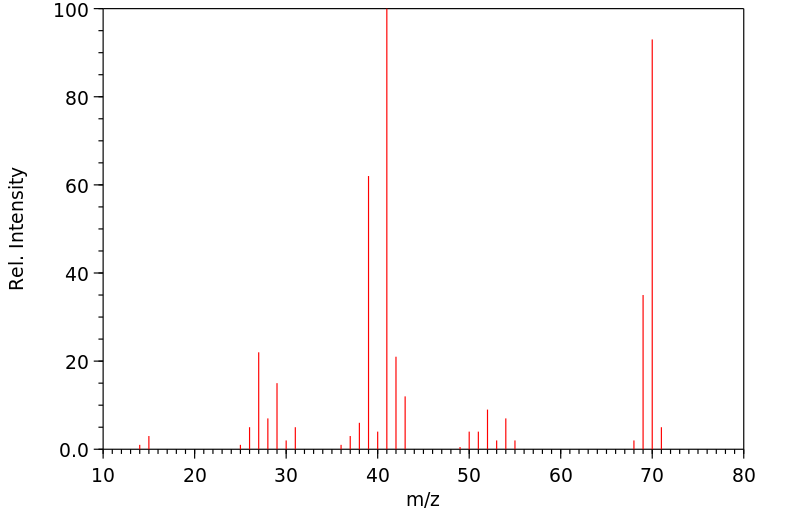(Z)-1,3-丁二烯-1-醇 | 70415-58-6
中文名称
(Z)-1,3-丁二烯-1-醇
中文别名
——
英文名称
(Z)-1-hydroxy-1,3-butadiene
英文别名
(Z)-1-hydroxybuta-1,3-diene;(Z)-1-hydroxybutadiene;(1Z)-buta-1,3-dien-1-ol
CAS
70415-58-6
化学式
C4H6O
mdl
——
分子量
70.091
InChiKey
LNDKRVOOYMEYTC-ARJAWSKDSA-N
BEILSTEIN
——
EINECS
——
-
物化性质
-
计算性质
-
ADMET
-
安全信息
-
SDS
-
制备方法与用途
-
上下游信息
-
文献信息
-
表征谱图
-
同类化合物
-
相关功能分类
-
相关结构分类
计算性质
-
辛醇/水分配系数(LogP):1.1
-
重原子数:5
-
可旋转键数:1
-
环数:0.0
-
sp3杂化的碳原子比例:0.0
-
拓扑面积:20.2
-
氢给体数:1
-
氢受体数:1
SDS
反应信息
-
作为反应物:描述:参考文献:名称:CAPON, BRIAN;GUO, BOZHANG, J. AMER. CHEM. SOC., 110,(1988) N 15, 5144-5147摘要:DOI:
-
作为产物:描述:参考文献:名称:简单的烯醇。5. (Z)- 和 (E)-1-Hydroxy-1,3-丁二烯摘要:Etude de la cinetique de cetonisation de l'enol du titre,制备 par 水解控制 du (butadiene-1,3yl trimethylsilyl) etherDOI:10.1021/ja00223a038
文献信息
-
Energy barriers to the Diels–Alder cycloadditions and cycloreversions of cation-radicals in the gas phase作者:František Tureček、Zdeněk HavlasDOI:10.1039/p29860001011日期:——mechanisms are operative in reactions which occur at their thermochemical thresholds. The reverse process, the Diels–Alder reaction of a cation-radical with a molecule, has a negligible activation energy for symmetrical and slightly unsymmetrical systems, [(Z)-1,2-dihydroxyethene]+˙+ cyclopentadiene, [cyclopentadiene]+˙+ vinyl alcohol, [(E)-1-hydroxybuta-1,3-diene]+˙+ cyclopentadiene, and [(Z)-1-hydroxybuta-1取代的双环[2.2.1]庚-2-烯阳离子自由基的逆Diels-Alder反应机理可能与碎片的能量有关。协调一致的同步或异步机制可在发生在其热化学阈值的反应中起作用。逆过程,即阳离子自由基与分子的Diels–Alder反应,对于对称和稍微不对称的体系[(Z)-1,2-二羟基乙烯] + ˙+环戊二烯,[环戊二烯] +的活化能可忽略不计˙+乙烯醇,[(E)-1-羟基丁-1,3-二烯] + ˙+环戊二烯和[(Z)-1-羟基丁-1,3-二烯] +˙+环戊二烯。高度不对称的2-乙烯基双环[2.2.1]庚-5-烯-2-醇阳离子自由基的逆Diels–Alder分解分两步进行,并克服了热化学反应之上的58–67 kJ mol –1的障碍临界点。讨论了键离解能对反应机理的影响。
表征谱图
-
氢谱1HNMR
-
质谱MS
-
碳谱13CNMR
-
红外IR
-
拉曼Raman
-
峰位数据
-
峰位匹配
-
表征信息
同类化合物
(反式)-4-壬烯醛
(s)-2,3-二羟基丙酸甲酯
([1-(甲氧基甲基)-1H-1,2,4-三唑-5-基](苯基)甲酮)
(Z)-4-辛烯醛
(S)-氨基甲酸酯β-D-O-葡糖醛酸
(S)-3-(((2,2-二氟-1-羟基-7-(甲基磺酰基)-2,3-二氢-1H-茚满-4-基)氧基)-5-氟苄腈
(R)-氨基甲酸酯β-D-O-葡糖醛酸
(5,5-二甲基-2-(哌啶-2-基)环己烷-1,3-二酮)
(2,5-二氟苯基)-4-哌啶基-甲酮
龙胆苦苷
龙胆二糖甲乙酮氰醇(P)
龙胆二糖丙酮氰醇(P)
龙胆三糖
龙涎酮
齐罗硅酮
齐留通beta-D-葡糖苷酸
鼠李糖
黑芥子苷单钾盐
黑海棉酸钠盐
黑木金合欢素
黑曲霉三糖
黑介子苷
黄尿酸8-O-葡糖苷
麻西那霉素II
麦迪霉素
麦芽糖脎
麦芽糖基海藻糖
麦芽糖1-磷酸酯
麦芽糖
麦芽四糖醇
麦芽四糖
麦芽十糖
麦芽六糖
麦芽五糖水合物
麦芽五糖
麦芽五糖
麦芽五糖
麦芽三糖醇
麦芽三糖
麦芽三糖
麦芽三塘水合
麦芽七糖水合物
麦芽七糖
麦法朵
麦可酚酸-酰基-Β-D-葡糖苷酸
麦利查咪
麝香酮
鹤草酚
鸢尾酚酮 3-C-beta-D-吡喃葡萄糖苷
鸡矢藤苷







